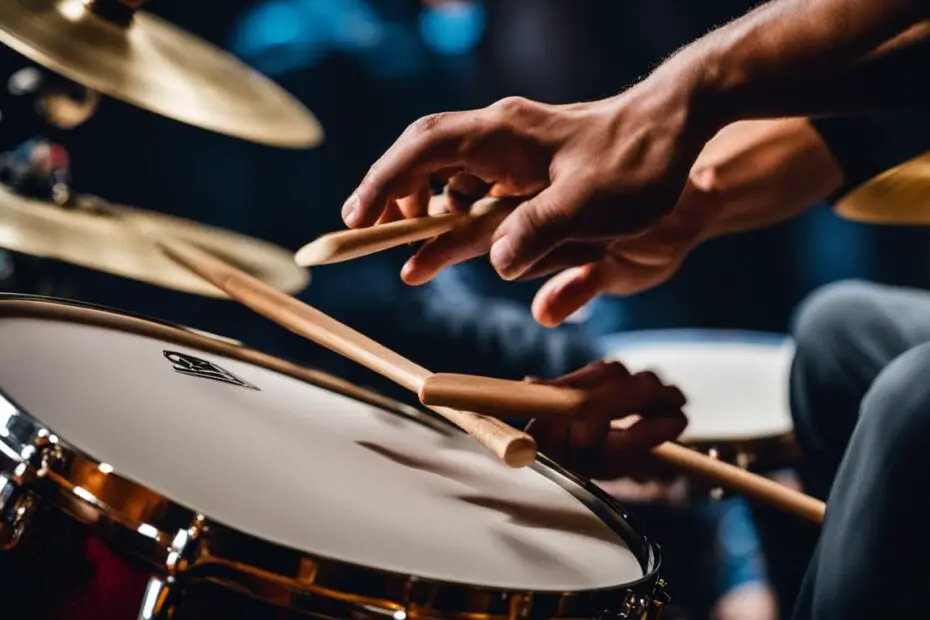The world of drumming is vast and exciting, offering a plethora of techniques, styles, and equipment options for music lovers. Whether you’re a beginner or an experienced drummer, this article will explore the various aspects of drumming, including techniques, lessons, styles, equipment, and accessories. Get ready to dive into the beat and discover new rhythms on your drum set.
Key Takeaways:
- Drumming offers endless opportunities for creativity and self-expression.
- There are various drumming techniques that beginners can learn to lay a solid foundation.
- Choosing the right drum set and equipment is crucial for an optimal drumming experience.
- Exploring different drumming styles and genres can broaden your musical horizons.
- Technology has revolutionized drumming, introducing electronic drums and other advancements.
The Most Iconic and Recognizable Drum Beats of All Time
Drum beats have the power to captivate audiences and make a song instantly recognizable. Throughout music history, certain drum beats have become iconic, forever etched into the hearts and minds of listeners. These beats not only showcase the skill and creativity of the drummers behind them but also serve as musical symbols of their respective songs and genres.
One of the most famous drum beats of all time is the opening to Queen’s “We Will Rock You” played by Roger Taylor. With its simple yet powerful rhythm of stomping and clapping, this beat has become synonymous with stadium anthems and is often chanted by fans during live performances. Another legendary beat is John Bonham’s thunderous groove in Led Zeppelin’s “When the Levee Breaks.” This beat, achieved by recording in a stairwell for its natural reverb, has been sampled and imitated countless times, cementing its place in rock music history.
Drum beats like these not only define songs but also influence entire genres. Phil Collins’ explosive drum fill in “In the Air Tonight” is instantly recognizable and has been emulated in countless songs across various musical styles. Stewart Copeland’s intricate and reggae-infused beat in The Police’s “Message in a Bottle” showcases the drummer’s unique style and contributes to the song’s energetic and infectious sound.
While these beats have become universally recognized, it’s important to note that there are also iconic drum beats specific to certain genres. For example, the driving and relentless beat in James Brown’s “Funky Drummer,” played by Clyde Stubblefield, is often sampled in hip-hop and funk tracks. Similarly, the intricate jazz patterns of Gene Krupa and Buddy Rich have left a lasting impact on the genre, inspiring countless drummers to experiment with complex rhythms and solos.
The Most Iconic Drum Beats in History
| Song | Drummer | Genre | Year |
|---|---|---|---|
| “We Will Rock You” | Roger Taylor | Rock | 1977 |
| “When the Levee Breaks” | John Bonham | Rock | 1971 |
| “In the Air Tonight” | Phil Collins | Rock/Pop | 1981 |
| “Message in a Bottle” | Stewart Copeland | New Wave/Rock | 1979 |
| “Funky Drummer” | Clyde Stubblefield | Funk | 1970 |
These are just a few examples of the most iconic and recognizable drum beats in history. Each beat carries with it a unique story and contribution to the world of music. As drummers continue to push the boundaries of rhythm and creativity, new beats are being added to this illustrious list, ensuring that the legacy of iconic drumming will continue to evolve.
The Evolution of Drumming: From Swing Era to Modern Styles
Drumming has a rich history that spans several decades, with its evolution closely tied to the changing musical landscape. The swing era, which emerged in the 1930s, played a significant role in shaping drumming techniques and styles. During this time, drummers like Gene Krupa and Buddy Rich popularized the use of big band orchestras, creating a demand for dynamic and rhythmic drumming.
Swing era drumming was characterized by its emphasis on improvised solos, syncopated rhythms, and powerful bass drum accents. Drummers showcased their technical prowess through energetic fills and explosive performances. This era witnessed the rise of drumming legends who pushed the boundaries of what was possible on the drums.
As music evolved and genres like rock, jazz, and funk emerged, drumming styles began to change. Modern drumming styles incorporated elements from various genres, resulting in a fusion of techniques and rhythms. Drummers like John Bonham, Stewart Copeland, and Dave Grohl brought a new level of power and intensity to their performances, revolutionizing the way drums are played.
Today, modern drumming styles encompass a wide range of techniques and approaches. Drummers continue to experiment with different sounds, incorporating electronic elements and unconventional rhythms into their playing. The evolution of drumming continues as new generations of drummers push the boundaries of what is possible on the instrument, creating innovative and exciting styles.
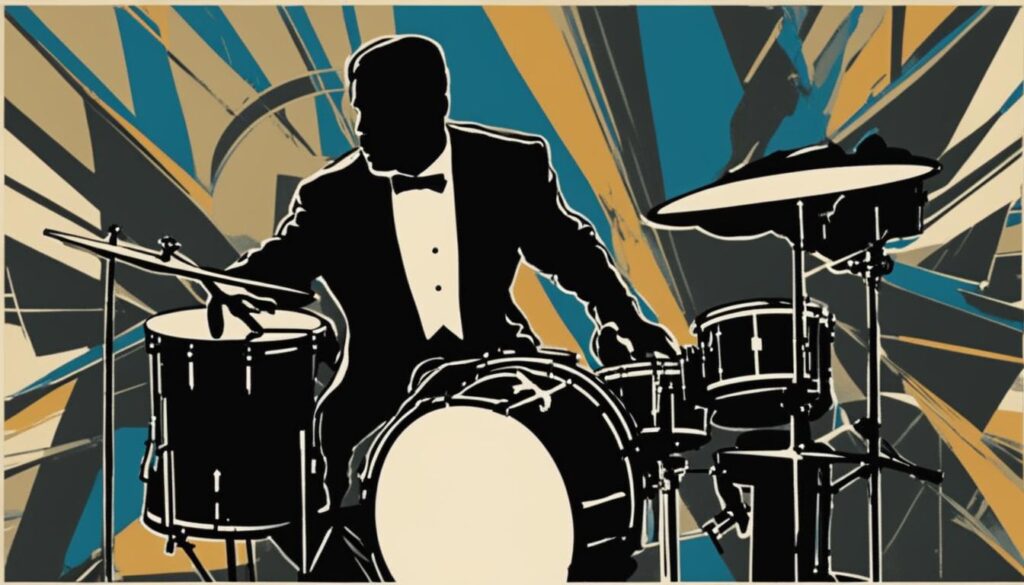
Table: Evolution of Drumming Styles
| Era | Style | Notable Drummers |
|---|---|---|
| Swing Era | Big Band | Gene Krupa, Buddy Rich |
| Rock Era | Classic Rock | John Bonham, Keith Moon |
| Jazz Fusion Era | Fusion | Billy Cobham, Steve Gadd |
| Alternative Era | Alternative Rock | Dave Grohl, Stewart Copeland |
| Contemporary Era | Experimental | Anika Nilles, Jojo Mayer |
Essential Drumming Techniques for Beginners
As a beginner drummer, it’s important to start with the right techniques to build a solid foundation for your drumming skills. Here are some essential drumming techniques that every beginner should learn:
- Bass Drum Technique: Mastering the technique of using the bass drum pedal is crucial for creating a solid rhythmic foundation. Practice playing steady and consistent bass drum beats with proper foot control.
- Snare Drum Technique: Develop control and precision in your snare drum playing technique by practicing various rudiments. Focus on achieving even strokes, consistent sound, and accurate hand positioning.
- Hand and Foot Coordination: Coordinating your hands and feet is essential for playing complex rhythmic patterns. Practice exercises that involve playing different rhythms with your hands and bass drum simultaneously.
- Stick Control: Work on improving your stick control by practicing exercises that focus on finger control, wrist movement, and rebounding. This will help you execute drumming patterns smoothly and efficiently.
- Dynamic Control: Learn to control the volume and intensity of your drumming by practicing dynamic variations. Experiment with playing soft and loud strokes to add depth and expression to your playing.
By mastering these essential drumming techniques, you’ll build a strong foundation and be well-equipped to explore more advanced drumming styles and techniques in the future.
Table: Essential Drumming Techniques for Beginners
| Technique | Description |
|---|---|
| Bass Drum Technique | Master the technique of using the bass drum pedal for steady and consistent beats. |
| Snare Drum Technique | Develop control and precision in snare drum playing technique with proper hand positioning. |
| Hand and Foot Coordination | Coordinate your hands and feet to play complex rhythmic patterns simultaneously. |
| Stick Control | Improve stick control through exercises focusing on finger control and rebounding. |
| Dynamic Control | Learn to control the volume and intensity of your drumming for expressive playing. |
Remember, practice is key when it comes to mastering drumming techniques. Take the time to practice each technique individually and gradually combine them to create more complex rhythms. With consistent practice and dedication, you’ll become a skilled drummer in no time.
Choosing the Right Drum Set and Equipment
When it comes to drumming, selecting the right drum set and equipment is essential for a fulfilling and enjoyable playing experience. Whether you’re a beginner or an experienced drummer, having the right tools can greatly impact your performance. But with so many options available, how do you choose?
When choosing a drum set, it’s important to consider your skill level, musical preferences, and budget. Beginners may opt for a basic beginner’s drum set, which typically includes a snare drum, bass drum, tom-toms, hi-hat cymbals, crash cymbals, and a ride cymbal. These sets are usually affordable and offer good value for money. For more advanced drummers, professional drum sets made from high-quality materials provide better sound projection and durability.
Drum equipment and accessories can also enhance your playing experience. Drumsticks come in various sizes and materials, each producing a different sound on the drumheads. Drumheads themselves can be made from plastic or animal skin, each offering a unique tone. Other accessories to consider include drum thrones, pedal systems, drum cases, and sound control devices like drum mutes or dampening gels.
| Drum Set Component | Suggested Materials |
|---|---|
| Bass Drum | Birch, Maple, or Mahogany |
| Snare Drum | Steel, Brass, or Birch |
| Tom-Toms | Birch, Maple, or Mahogany |
| Cymbals | Brass or B20 Bronze |
| Drumsticks | Hickory or Maple |
It’s worth noting that different drumming styles and genres may require specific equipment. For example, jazz drummers may prefer smaller drum sizes and lighter cymbals, while metal drummers may opt for larger drums and heavier cymbals for a more aggressive sound. It’s important to experiment with different equipment and find what works best for your personal style.
Over time, drum sets and equipment have undergone advancements and innovations. Electronic drums have become a popular alternative, allowing drummers to practice silently with headphones or create unique electronic sounds. Drum triggers and sampling pads also provide options for adding electronic elements to acoustic drum performances. These developments offer drummers exciting new possibilities for creativity and musical expression.
In conclusion, choosing the right drum set and equipment is a personal decision that should take into account your skill level, musical preferences, and budget. Consider the materials, components, and accessories that best suit your needs and experiment with different options to find your unique sound. Whether you prefer acoustic or electronic drums, the right equipment will enhance your drumming experience and help you reach new heights as a musician.
Exploring Different Drumming Styles and Genres
Drumming is a versatile art form that encompasses various styles and genres, each with its own unique characteristics and rhythms. From the thunderous beats of rock and roll to the intricate patterns of jazz and the infectious grooves of hip-hop, drumming styles have evolved and branched out over the years, reflecting the diverse musical landscape.
One of the most popular drumming genres is rock, known for its energetic and driving rhythms. Drummers in rock bands often employ powerful strokes and heavy use of cymbals to create a powerful and dynamic sound. Jazz, on the other hand, focuses on improvisation and intricate syncopated rhythms. Jazz drummers showcase their technical prowess through complex polyrhythms and drum solos.
Hip-hop drumming is characterized by its use of drum machines, samplers, and electronic elements. Drummers in hip-hop bands and productions often create loops and beats using electronic drum pads and software. This genre emphasizes the importance of timing, groove, and creating a solid foundation for rap vocals.
“Drumming is not just about hitting the drums; it’s about creating a rhythm that moves people’s hearts and souls.” – Unknown
The influence of cultural traditions
Drumming styles and genres are not limited to Western music. Different cultures around the world have their own unique drumming traditions, each with its own distinct rhythms and techniques. For example, Latin American music heavily relies on percussion instruments such as congas, bongos, and timbales. Afro-Cuban rhythms, samba, and bossa nova are just a few examples of the vibrant and infectious drumming styles from this region.
Traditional African drumming is another rich and diverse genre that has influenced many other styles of music. African drumming often involves intricate polyrhythms, call and response patterns, and a strong emphasis on communal playing. These drumming traditions have had a profound impact on genres such as jazz, reggae, and world music.
Evolution and fusion
Over time, drumming styles and genres have continued to evolve, adapting to new musical trends and technological advancements. With the rise of electronic music, drummers have embraced electronic drum kits, drum triggers, and various effects to create unique sounds and textures. This fusion of acoustic and electronic elements has given birth to new genres such as electronic rock and EDM.
Furthermore, many drummers today incorporate elements from different styles and genres, creating a hybrid of influences. This cross-pollination of musical ideas has led to the emergence of fusion genres like jazz-rock, funk-metal, and Afrobeat. Drummers who explore these hybrid styles often have an eclectic approach, drawing inspiration from various musical traditions.
| Music Genre | Characteristics | Notable Drummers |
|---|---|---|
| Rock | Energetic, heavy use of cymbals and powerful strokes | John Bonham, Neil Peart, Dave Grohl |
| Jazz | Improvisation, syncopated rhythms, complex polyrhythms | Max Roach, Art Blakey, Tony Williams |
| Hip-hop | Use of drum machines, samplers, electronic elements | Ahmir “Questlove” Thompson, Travis Barker, J Dilla |
| Latin | Percussion instruments, infectious rhythms | Tito Puente, Poncho Sanchez, Giovanni Hidalgo |
| African | Polyrhythms, call and response, communal playing | Tony Allen, Babatunde Olatunji, Fela Kuti |
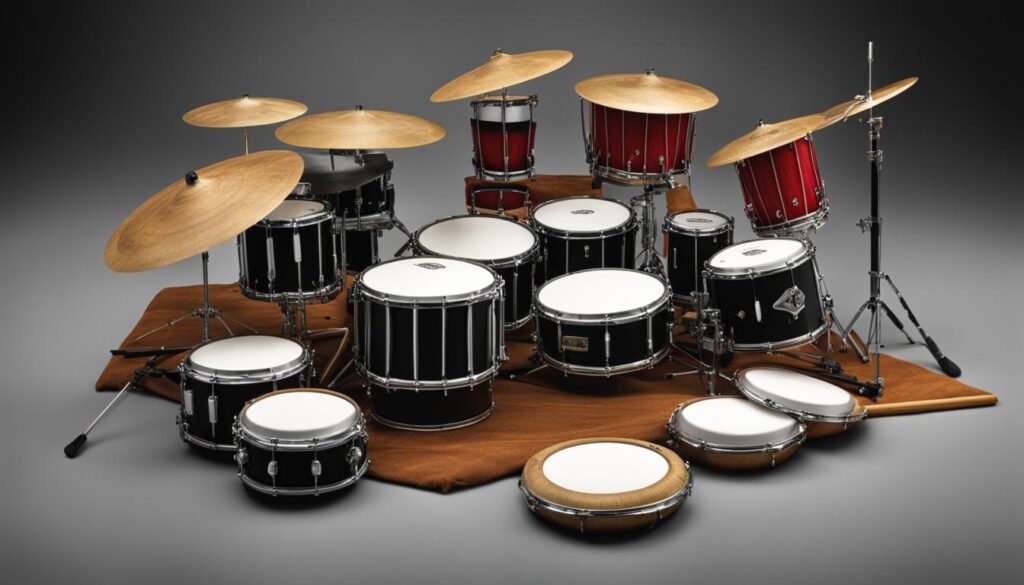
Exploring different drumming styles and genres allows drummers to expand their musical horizons and develop their own unique voice behind the drum kit. By embracing the techniques, rhythms, and traditions of various genres, drummers can enhance their creativity and versatility, ultimately becoming well-rounded musicians.
Drum Lessons: Finding the Right Teacher or Online Resources
When it comes to learning to play the drums, finding the right teacher or online resources can make all the difference in your progress and enjoyment. Whether you prefer the personalized guidance of a drum teacher or the convenience of online tutorials, there are various options available to suit your learning style and goals.
| Option | Pros | Cons |
|---|---|---|
| Drum Teacher |
|
|
| Online Resources |
|
|
It’s important to consider your learning preferences, budget, and availability when choosing between a drum teacher and online resources. If you thrive in a one-on-one learning environment and value the guidance and feedback of an experienced instructor, investing in drum lessons with a qualified teacher may be the best option for you. On the other hand, if you prefer the convenience and flexibility of learning at your own pace, online resources can provide a wealth of tutorials and lessons to explore.
“The great thing about drumming is that there is no one-size-fits-all approach to learning. Whether you choose a drum teacher or online resources, what matters most is your commitment to practice and your passion for the instrument.”
– Drumming Enthusiast
Regardless of whether you choose a drum teacher or online resources, it’s important to stay motivated and consistent in your practice. Set goals for yourself, practice regularly, and don’t be afraid to experiment and explore different techniques. With the right guidance and resources, you can embark on an exciting drumming journey and develop the skills to express yourself through the power of rhythm.
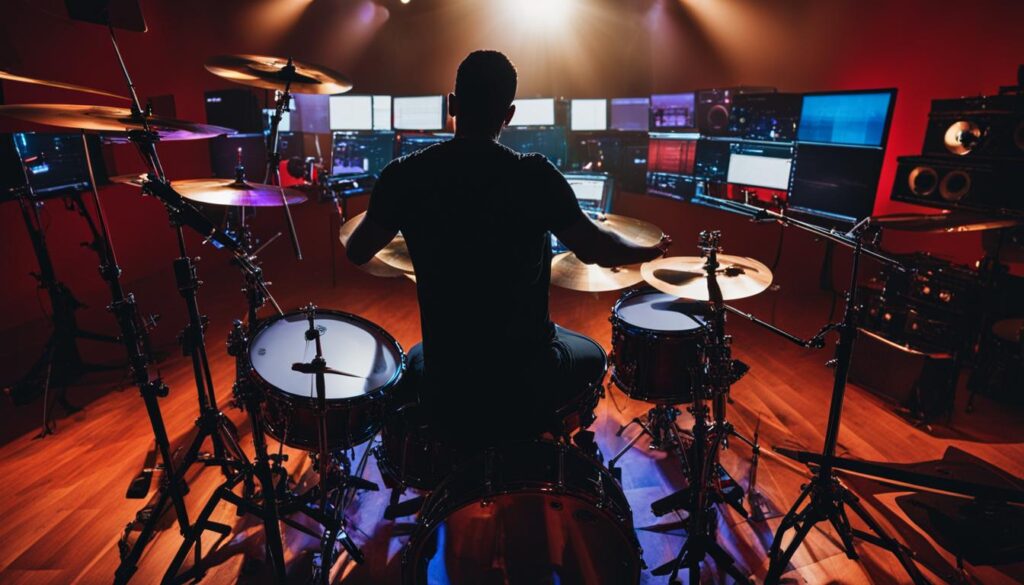
Must-Have Drumming Accessories for Every Drummer
Drumming accessories play a vital role in enhancing a drummer’s performance and expanding their creative possibilities. From drumsticks to hardware, these tools are essential for achieving the desired sound and adding depth to the music. Let’s explore some of the must-have drumming accessories that every drummer should consider adding to their arsenal.
Drumsticks
Drumsticks are the most crucial tool for drummers, as they directly influence the feel and sound produced. They come in various sizes, materials, and tip shapes, allowing drummers to achieve different tones and play with versatility. Whether you prefer the warmth of wooden drumsticks or the durability of synthetic ones, choosing the right pair is essential for optimal playability and sound projection.
Cymbals
Cymbals are another indispensable element of a drum set, providing accents, crashes, and ride patterns to enhance the overall sound. From hi-hats to crashes and rides, each type of cymbal offers a unique timbre and response. When selecting cymbals, consider factors such as size, thickness, and material to cater to your desired playing style and musical genre.
Hardware
Drummers rely on hardware components to ensure stability and adjustability while playing. Sturdy and durable hardware not only provides the necessary support for the drum set but also allows drummers to customize their setup according to their preferences. Essential hardware includes snare stands, bass drum pedals, hi-hat stands, and cymbal stands, among others.
Other percussion instruments like cowbells, tambourines, and shakers can also add depth and variety to a drummer’s performance. These instruments can be incorporated into drumming patterns to create rhythmic interest and enhance the overall musical experience. Explore different percussive possibilities to find the perfect balance between traditional drumming and additional textures.
With the right combination of drumming accessories and percussion instruments, drummers can elevate their performances and explore new musical horizons. From finding the perfect pair of drumsticks to selecting cymbals that complement their style, every accessory contributes to the unique voice of a drummer. So, make sure to equip yourself with the must-have drumming accessories and let your creativity soar.
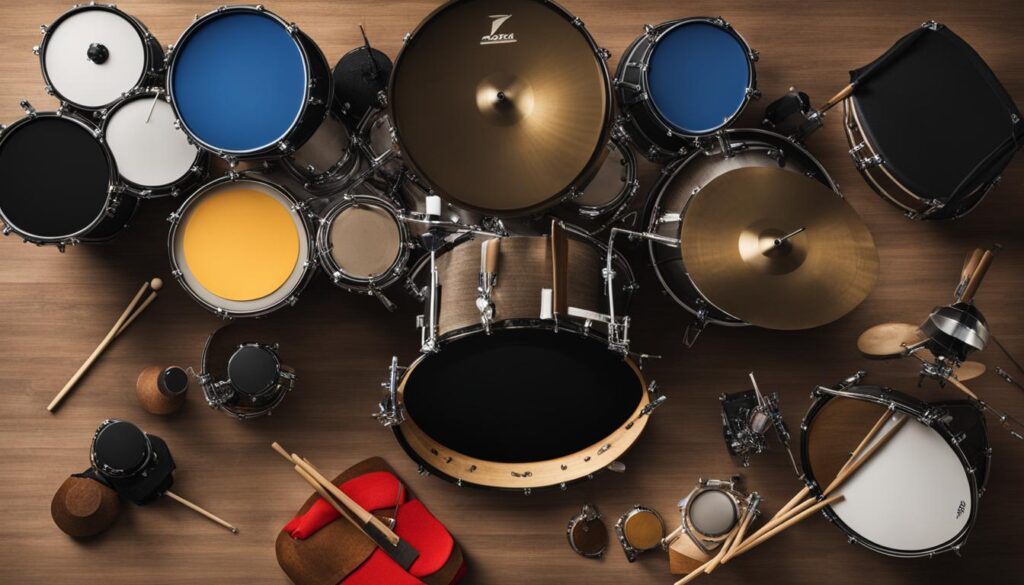
The Influence of Technology on Drumming
Technology has had a profound impact on the world of drumming, revolutionizing the way drummers create and perform music. One of the notable advancements is the introduction of electronic drums. These innovative instruments provide drummers with a wide range of sounds and effects, allowing them to explore new sonic territories. Electronic drums also offer the advantage of being easily portable and customizable, making them a popular choice for drummers who frequently travel or perform in different settings.
In addition to electronic drums, technology has also transformed the way drummers sample and create unique sounds. Drum sampling involves recording and manipulating various drum sounds, which can then be triggered and played back during performances or studio recordings. This technique has opened up a world of possibilities for drummers, enabling them to incorporate unconventional sounds and textures into their music.
Furthermore, technology has led to the development of sophisticated digital interfaces and software that enhance the drumming experience. Drummers can now utilize advanced tools for recording, editing, and mixing their drum tracks, giving them greater control and creativity in the studio. These digital interfaces also enable drummers to connect with other musicians and collaborate remotely, expanding the possibilities of musical collaboration.

Overall, technology has significantly expanded the horizons of drumming, providing drummers with endless opportunities for creativity and innovation. While traditional acoustic drums will always hold a special place in the world of drumming, the integration of technology has undoubtedly enriched the art form, pushing boundaries and challenging conventions.
The Future of Drumming: Trends and Innovations
As the world of music continues to evolve, so does the art of drumming. The future of drumming holds exciting possibilities, with new trends and innovations on the horizon. Drummers are constantly pushing the boundaries and exploring new techniques, styles, and technologies to enhance their performances. In this section, we will take a closer look at the future of drumming, including emerging trends, innovative technologies, and the evolving role of drummers in the music industry.
Emerging Trends in Drumming
One of the most notable trends in drumming is the integration of electronic elements into traditional drum sets. Electronic drums have gained popularity due to their versatility and the ability to produce a wide range of sounds and effects. Drummers are now incorporating electronic pads, triggers, and sample pads into their setups, allowing them to explore new sonic landscapes and add unique textures to their performances.
Another emerging trend is the use of hybrid drum sets, which combine acoustic drums with electronic components. These hybrid setups offer drummers the best of both worlds, allowing them to enjoy the authentic feel and sound of acoustic drums while taking advantage of the digital capabilities of electronic drums. Hybrid drum sets provide endless creative possibilities, enabling drummers to experiment with different sounds and textures in their performances.
Innovations Shaping the Drumming World
Technology continues to play a significant role in shaping the future of drumming. Drumming apps have become increasingly popular, providing drummers with a wide range of tools and resources right at their fingertips. These apps offer features such as metronomes, drum machine simulations, practice exercises, and even virtual drumming lessons. Drummers can now access a wealth of knowledge and practice tools on their smartphones or tablets, making learning and improving their skills more accessible than ever before.
Virtual reality (VR) technology is also making its way into the drumming world, creating immersive drumming experiences. VR drumming allows drummers to step into a virtual environment where they can play alongside virtual bandmates or in fantasy settings, enhancing the overall musical experience. This innovative technology opens up new possibilities for performances, practice sessions, and even collaborative jam sessions with other musicians from around the world.
The Evolution of Drummers
As drumming techniques and technologies continue to evolve, so does the role of drummers in the music industry. Drummers are no longer confined to the traditional role of keeping the rhythm. They have become more versatile and are actively involved in the creative process, contributing to the songwriting, production, and arrangement of music. Drummers are now seen as integral members of a band or musical ensemble, bringing their unique musicality and creative input to the table.
In conclusion, the future of drumming is filled with exciting trends and innovations. From the integration of electronic elements and hybrid drum sets to the use of drumming apps and virtual reality technology, drummers are embracing new tools and techniques to push the boundaries of their craft. As technology continues to advance, we can expect even more groundbreaking developments that will shape the future of drumming and redefine the possibilities of music.
Conclusion
Drumming is a captivating and ever-evolving art form that offers endless possibilities for musicians. Throughout this article, we have explored the diverse aspects of drumming, from iconic drum beats to essential techniques for beginners. We have delved into the evolution of drumming, the different drumming styles and genres, and the influence of technology on this dynamic art form.
Drumming serves as a powerful form of self-expression, allowing drummers to create unique rhythms and convey emotions through their beats. The world of drumming is filled with a rich history and a vibrant community of passionate drummers.
As drummers continue to push boundaries and explore new horizons, the future of drumming holds exciting trends and innovations. From virtual reality drumming to drumming apps, technology is shaping the way drummers create and perform.
Whether you are a beginner or an experienced drummer, the world of drumming invites you to embrace the beat and embark on a lifelong journey of creativity and self-discovery. So pick up your sticks, find your rhythm, and let the drums be your guide as you explore the captivating world of drumming.
FAQ
What are some famous drum beats in history?
Some iconic drum beats include Neal Smith’s flam intro in “Billion Dollar Babies” and Dave Brubeck’s 5/4 pattern in “Take Five.”
How has drumming evolved over the years?
Drumming has evolved from its integration into popular music during the Swing Era in the 1930s to modern styles in various genres.
What are some essential drumming techniques for beginners?
Beginners should learn basic drum rudiments, hand and foot coordination exercises, and stick control.
How do I choose the right drum set and equipment?
Consider your skill level, musical preferences, and budget when selecting a drum set, cymbals, pedals, and other accessories.
What are some different drumming styles and genres?
Drumming encompasses various styles and genres such as rock, jazz, hip-hop, and Latin.
What are the benefits of taking drum lessons?
Drum lessons can enhance your skills and knowledge, and you can choose between in-person lessons or online resources.
What are some must-have drumming accessories?
Essential drumming accessories include drumsticks, drum heads, hardware, and percussion instruments like cowbells and tambourines.
How has technology influenced drumming?
Technology has introduced electronic drums, drum sampling, and other advancements that have revolutionized drumming.
What are some emerging trends in drumming?
Emerging trends include virtual reality drumming and drumming apps that offer new possibilities for drummers.


